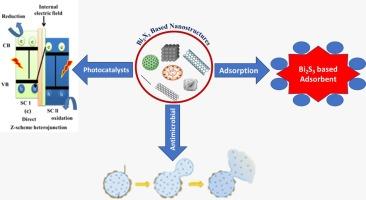Bismuth chalcogenide assisted Nanomaterials: A versatile platform against harmful bacteria and toxic organic moieties
Q1 Environmental Science
Environmental Nanotechnology, Monitoring and Management
Pub Date : 2024-09-29
DOI:10.1016/j.enmm.2024.101010
引用次数: 0
Abstract
Water pollution caused by toxic organic compounds (Dyes, agrochemicals, antibiotics, etc.) and waterborne bacteria presents significant global challenges that demand innovative solutions. Nanomaterials have emerged as a promising alternative to traditional water treatment methods due to their unique properties, such as antimicrobial and photocatalytic activities, as well as superior adsorption capabilities. Among these, bismuth chalcogenides (Bi2S3, Bi2O3, Bi2Se3) have attracted considerable interest for their low toxicity, suitable band gaps in the visible spectrum, and potent antimicrobial properties. This review examines the significant role of bismuth chalcogenide-based single and multiphase nanostructures in addressing water pollution through photocatalytic degradation, adsorption, and antimicrobial processes. Despite excellent photocatalytic activity of single phase bismuth chalcogenides nanomaterials, it also enhances visible light absorption capacity of UV active materials (TiO2, ZnO etc.) in combine state. It delves into the antimicrobial mechanisms of bismuth chalcogenides and explores their enhanced efficacy when combined with loaded drugs, natural bioactive compounds, and doped metals such as silver (Ag) and gold (Au). The review also provides an in-depth discussion on the challenges associated with synthesizing bismuth chalcogenide nanomaterials and their potential applications in water purification.

卤化铋辅助纳米材料:对抗有害细菌和有毒有机分子的多功能平台
有毒有机化合物(染料、农用化学品、抗生素等)和水传播细菌造成的水污染是全球性的重大挑战,需要创新的解决方案。纳米材料因其独特的性能,如抗菌和光催化活性,以及卓越的吸附能力,已成为传统水处理方法的一种有前途的替代品。其中,铬化铋(Bi2S3、Bi2O3、Bi2Se3)因其毒性低、在可见光谱中具有合适的带隙以及强大的抗菌性能而引起了人们的极大兴趣。本综述探讨了基于铬化铋的单相和多相纳米结构在通过光催化降解、吸附和抗菌过程解决水污染问题方面的重要作用。尽管单相铬化铋纳米材料具有出色的光催化活性,但它也能增强紫外线活性材料(TiO2、ZnO 等)在结合态下的可见光吸收能力。综述深入探讨了铬化铋的抗菌机制,并探讨了它们与负载药物、天然生物活性化合物以及掺杂金属(如银(Ag)和金(Au))结合后的增强功效。综述还深入探讨了与合成铬化铋纳米材料相关的挑战及其在水净化领域的潜在应用。
本文章由计算机程序翻译,如有差异,请以英文原文为准。
求助全文
约1分钟内获得全文
求助全文
来源期刊

Environmental Nanotechnology, Monitoring and Management
Environmental Science-Water Science and Technology
CiteScore
13.00
自引率
0.00%
发文量
132
审稿时长
48 days
期刊介绍:
Environmental Nanotechnology, Monitoring and Management is a journal devoted to the publication of peer reviewed original research on environmental nanotechnologies, monitoring studies and management for water, soil , waste and human health samples. Critical review articles, short communications and scientific policy briefs are also welcome. The journal will include all environmental matrices except air. Nanomaterials were suggested as efficient cost-effective and environmental friendly alternative to existing treatment materials, from the standpoints of both resource conservation and environmental remediation. The journal aims to receive papers in the field of nanotechnology covering; Developments of new nanosorbents for: •Groundwater, drinking water and wastewater treatment •Remediation of contaminated sites •Assessment of novel nanotechnologies including sustainability and life cycle implications Monitoring and Management papers should cover the fields of: •Novel analytical methods applied to environmental and health samples •Fate and transport of pollutants in the environment •Case studies covering environmental monitoring and public health •Water and soil prevention and legislation •Industrial and hazardous waste- legislation, characterisation, management practices, minimization, treatment and disposal •Environmental management and remediation
 求助内容:
求助内容: 应助结果提醒方式:
应助结果提醒方式:


